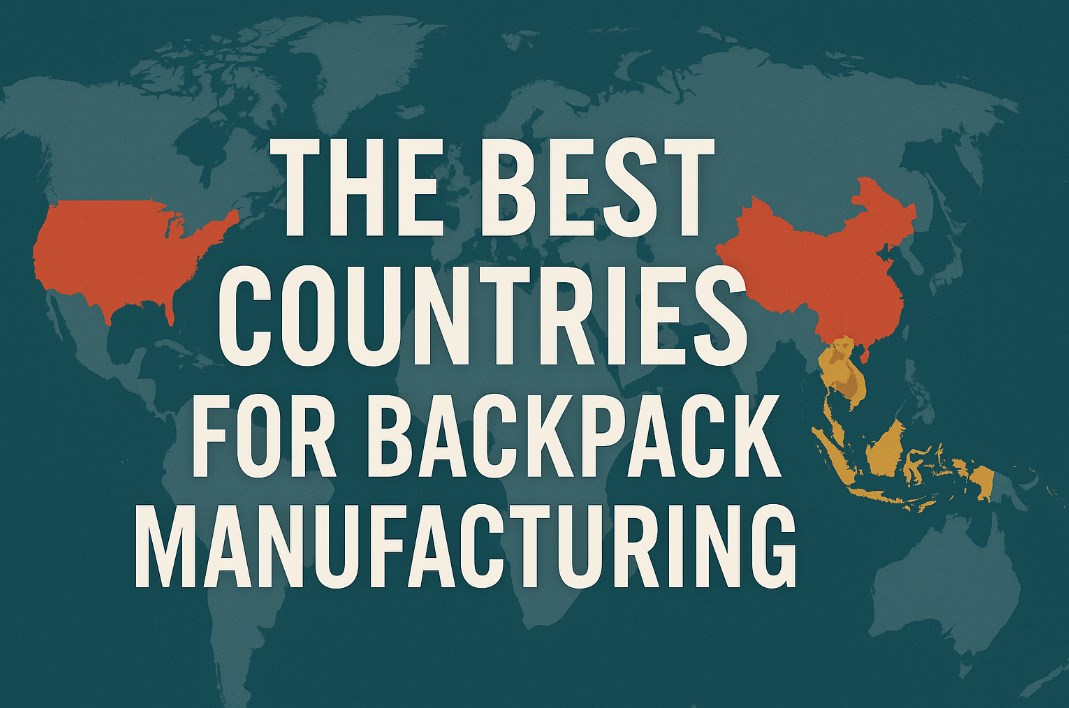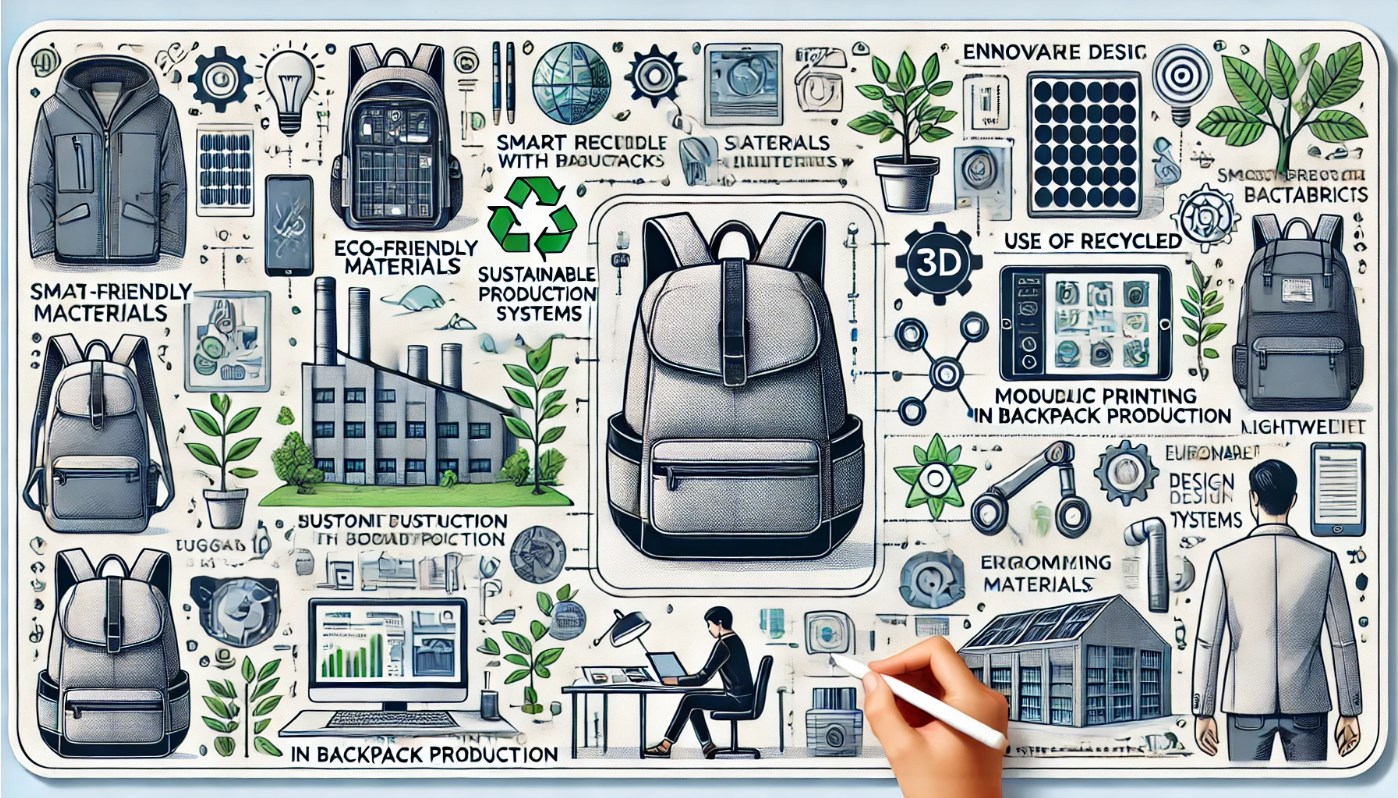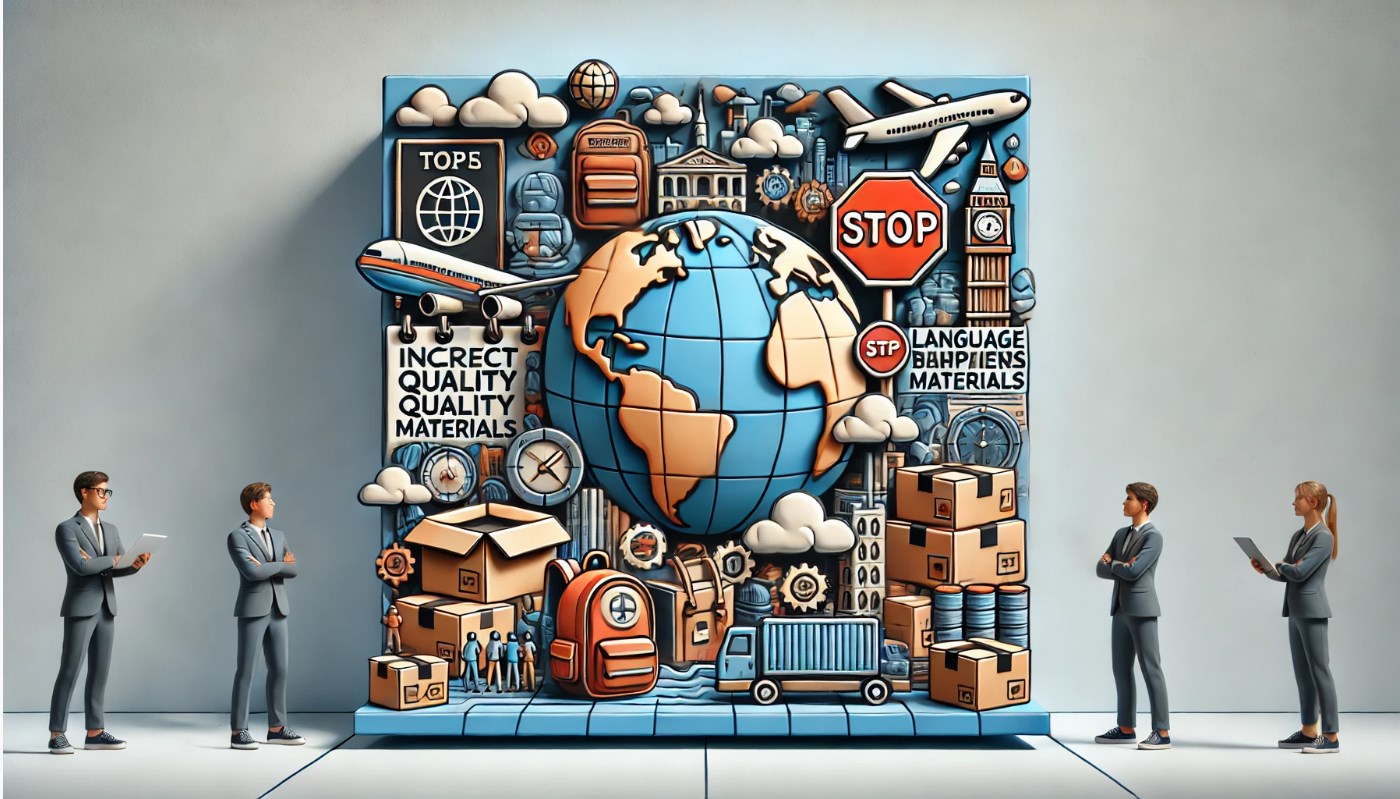Backpack manufacturing is a global business with an intricate balance of cost, quality, and logistics. The right manufacturing location can significantly influence the product’s cost structure, shipping efficiency, and overall quality.

Key Factors in Backpack Manufacturing
Material Sourcing and Quality Control
Backpacks require a variety of materials including fabrics (such as polyester, nylon, or canvas), leather, zippers, buckles, and foam for padding. The quality of these materials is crucial to the overall performance and durability of the backpack. For manufacturers, sourcing high-quality materials is a priority. Countries with established textile industries and easy access to raw materials are typically preferred for backpack production. Additionally, countries with stringent quality control processes ensure that the final product meets international standards and customer expectations.
Labor Costs and Workforce Skills
Backpack manufacturing often involves intricate stitching, precise sewing, and assembly of different parts such as straps, zippers, and compartments. A skilled workforce is essential to ensure that backpacks are durable, functional, and aesthetically pleasing. Labor costs can vary significantly between countries, influencing the overall cost of production. Countries with both a low labor cost and a well-trained workforce offer a strong combination for manufacturers seeking to keep production costs low while maintaining quality.
Logistics and Shipping
Proximity to key global markets can make a significant difference in the speed and cost of shipping. Efficient port infrastructure, good road networks, and proximity to major shipping lanes are all important factors to consider. Shipping time directly impacts delivery schedules, and long delays can affect the manufacturer’s bottom line, particularly for brands targeting fast-moving consumer markets. Countries with modern logistics infrastructure and favorable shipping conditions tend to attract global backpack brands.
Environmental and Ethical Considerations
Sustainability has become an essential consideration for backpack manufacturers. Ethical manufacturing processes, fair labor practices, and eco-friendly materials are increasingly important to consumers. Countries with strong environmental regulations and an emphasis on ethical labor practices are preferred for producing backpacks, especially by brands that focus on sustainability. As a result, many companies prioritize suppliers that use recycled materials or non-toxic dyes and have transparent and fair labor practices.
China: The Largest Player in Backpack Manufacturing
Infrastructure and Manufacturing Expertise
For decades, China has been the epicenter of global manufacturing, and backpack production is no exception. The country has developed an unparalleled manufacturing infrastructure with state-of-the-art factories, well-established supply chains, and access to an abundant labor force. China’s scale of production makes it especially suitable for high-volume manufacturing of backpacks, from basic models to more complex designs. The availability of skilled labor, sophisticated machinery, and the ability to quickly scale production sets China apart as a manufacturing powerhouse.
China’s extensive experience in manufacturing allows for the production of a wide range of backpacks, from budget-friendly options to high-end, feature-rich backpacks. Many of the world’s leading backpack brands, including high-performance outdoor gear companies, have manufacturing facilities in China due to its expertise in producing durable and high-quality products.
Cost-Effectiveness
Despite rising labor costs in recent years, China remains one of the most cost-effective countries for backpack manufacturing, particularly for large-scale orders. Economies of scale, access to cheap raw materials, and highly efficient production processes enable manufacturers in China to produce high-quality backpacks at lower costs. The availability of mass production capabilities means that costs per unit decrease significantly for bulk orders, making China an attractive option for businesses looking to keep production costs down.
Shipping and Logistics
China is well-connected to global markets through its world-class ports, such as Shanghai, Shenzhen, and Ningbo, allowing for quick and reliable shipping to North America, Europe, and beyond. The country’s advanced logistics infrastructure further supports this by offering quick turnaround times, reducing lead times and costs. As the world’s largest exporter, China’s efficient logistics network and proximity to international shipping lanes make it an excellent choice for companies that require rapid and affordable shipping.
Challenges
Despite China’s dominance in backpack manufacturing, challenges exist. These include rising labor costs, increasing regulatory scrutiny, and intellectual property concerns. While China has made strides in enforcing IP protection, manufacturers still face the risk of counterfeiting. Additionally, concerns about the environmental impact of mass production, such as waste and pollution, have led many companies to explore more sustainable alternatives in other regions.
Vietnam: The Rising Star in Backpack Manufacturing
Competitive Labor Costs
Vietnam has emerged as a strong competitor to China in the global manufacturing market, largely due to its competitive labor costs and growing manufacturing sector. Labor in Vietnam is relatively inexpensive compared to China, making it an appealing option for backpack manufacturers who are looking for a low-cost alternative while still maintaining a high level of craftsmanship. Vietnam’s workforce is highly skilled, particularly in textiles and apparel, which makes it well-suited for backpack production.
Vietnam’s government has made significant efforts to improve the country’s manufacturing capabilities, offering incentives to foreign investors and ensuring a steady supply of skilled workers. The country has built a strong reputation for producing high-quality products, making it a popular choice for businesses looking to manufacture mid-to-high range backpacks.
Proximity to Raw Materials
Vietnam is geographically close to key textile and apparel manufacturing hubs in Southeast Asia, allowing for easier access to raw materials. The country benefits from a well-developed supply chain for textiles, zippers, buckles, and other backpack components. Additionally, it has access to abundant natural resources, including rubber, which is used in the production of padding and straps for backpacks.
Free Trade Agreements
Vietnam is a signatory to several free trade agreements (FTAs) with key markets, such as the European Union, Japan, and South Korea. These trade agreements make it easier for manufacturers to export backpacks without paying high tariffs, reducing the overall cost of production. The country’s strategic position within Southeast Asia, coupled with these trade agreements, makes it an ideal location for companies seeking to access global markets.
Challenges
While Vietnam offers many benefits, it still faces challenges in terms of its infrastructure and regulatory environment. Although logistics are improving, the country does not yet have the same level of infrastructure development as China. This can sometimes result in delays or higher shipping costs. Additionally, although Vietnam’s workforce is highly skilled, the overall size of its labor pool is smaller than China’s, which could limit large-scale production capabilities for certain brands.
Bangladesh: Affordable Manufacturing with Growing Capabilities
Low Labor Costs
Bangladesh is known for its extremely low labor costs, making it one of the most affordable countries for backpack manufacturing. With an established textile industry that focuses on garments and bags, Bangladesh has become a key player in the production of affordable backpacks. Companies looking to produce budget-friendly backpacks often turn to Bangladesh for its low labor costs and competitive manufacturing environment.
Government Support
The Bangladeshi government has actively supported the development of its manufacturing sector through initiatives such as special economic zones (SEZs), tax incentives, and investment in infrastructure. These efforts have helped the country to remain an attractive destination for global brands looking to produce products at a lower cost. Additionally, the country has made strides in improving labor conditions, although challenges remain.
Ethical Manufacturing and Quality Control
Despite its low labor costs, Bangladesh has made significant efforts to improve its labor conditions and implement sustainable practices. Many factories are now certified by global organizations like the Fair Trade Federation, ensuring ethical manufacturing processes. This focus on improving working conditions and adhering to international labor standards has made Bangladesh a viable option for companies that prioritize both affordability and ethical production.
Challenges
Bangladesh faces challenges in infrastructure development, particularly in transportation and logistics. Ports are functional but not as advanced as those in China or Vietnam, leading to potential delays. The country’s manufacturing sector also faces some challenges in terms of quality control, especially in factories with lower investment in technology. However, the government is working to address these issues, and the overall outlook for Bangladesh remains positive.
India: A Diverse Manufacturing Hub with High Craftsmanship
Skilled Workforce and Craftsmanship
India has a long history of craftsmanship in textiles, leather goods, and accessories. This makes it an excellent choice for manufacturing high-quality backpacks, especially those made from leather or other premium materials. India’s diverse labor force is skilled in handcrafting, embroidery, stitching, and other intricate details that are often required for premium backpack designs.
Competitive Labor Costs
Labor costs in India are relatively low compared to developed countries, and the country offers a wide range of manufacturing options, from small-scale artisan workshops to large-scale factories. This flexibility makes India an attractive choice for brands looking for a balance of quality and cost.
Material Sourcing and Sustainability
India has an established leather industry and a growing sector of sustainable fabric production. As consumers increasingly demand eco-friendly products, India is well-positioned to meet this need with its growing availability of organic and recycled materials. Manufacturers in India are also exploring sustainable production techniques, such as using plant-based dyes and non-toxic materials.
Challenges
India’s manufacturing sector faces challenges related to infrastructure, regulatory complexities, and occasional political instability. While the country has made significant strides in improving its manufacturing environment, logistical inefficiencies can still pose a risk for brands that need fast turnarounds.
Cambodia: A Newcomer with Cost Advantages
Labor Costs and Growing Manufacturing Sector
Cambodia is an emerging destination for backpack manufacturing, particularly because of its low labor costs. As a new player in the global manufacturing scene, Cambodia offers a fresh opportunity for businesses looking to manufacture backpacks at competitive prices. The country’s growing manufacturing capabilities, particularly in textiles and garments, make it an attractive choice for cost-conscious brands.
Favorable Trade Agreements
Cambodia benefits from several trade agreements that make it easier to export goods to key markets such as the European Union and the United States. These preferential trade terms, coupled with low labor costs, make Cambodia an appealing choice for businesses that want to keep manufacturing costs low while gaining access to large international markets.
Ethical Manufacturing
Cambodia is increasingly adopting ethical manufacturing practices, with many factories achieving certifications for labor rights and environmental standards. The country is taking steps to address concerns related to working conditions, and many factories now operate in line with international standards for sustainable production.
Challenges
Cambodia’s manufacturing infrastructure is still developing, and logistical inefficiencies can sometimes lead to delays. Additionally, the country has a smaller workforce compared to neighboring nations like Vietnam and China, which may limit scalability for larger brands.
Indonesia: Strategic Location and Growing Capabilities
Textile Industry and Raw Materials
Indonesia has a well-established textile industry, providing a steady supply of raw materials for backpack production. The country also produces a variety of natural fibers, such as cotton, which are often used in backpack manufacturing. Indonesia’s manufacturing sector has grown steadily in recent years, and the country is becoming an increasingly popular choice for producing backpacks.
Low Labor Costs
Labor costs in Indonesia are among the lowest in Southeast Asia, which makes it a cost-effective option for companies looking to reduce production expenses. Despite these low costs, Indonesia has a skilled workforce with expertise in textiles and leather, making it a suitable destination for producing both basic and premium backpacks.
Trade Agreements
As part of the ASEAN Free Trade Area (AFTA), Indonesia enjoys reduced tariffs and trade advantages for exports to other ASEAN countries, as well as major markets like Japan and China. This gives manufacturers in Indonesia access to a broad regional market with fewer barriers.
Challenges
While Indonesia has many advantages, it does face challenges in terms of infrastructure. Shipping times can be slower, and transportation costs can be higher than in countries like China or Vietnam. However, the Indonesian government is investing heavily in infrastructure improvements, which may alleviate these challenges in the future.
Mexico: The Nearshoring Advantage for North American Brands
Proximity to the United States
For brands targeting the North American market, Mexico presents a unique advantage due to its proximity to the United States. Manufacturers in Mexico benefit from lower labor costs compared to the U.S., while reducing shipping times and costs. This proximity allows for quicker turnarounds and more efficient supply chains for companies targeting North American consumers.
Trade Agreements and Favorable Export Terms
Mexico is a key player in the United States-Mexico-Canada Agreement (USMCA), which offers favorable trade terms for products exported to the United States. This agreement allows Mexican manufacturers to ship goods to the U.S. tariff-free, making it an attractive option for North American brands looking to keep costs low while ensuring fast delivery.
Growing Manufacturing Sector
Mexico has seen a surge in manufacturing over the past few decades, with a focus on the automotive, electronics, and textile industries. The country’s manufacturing capabilities continue to grow, and many global companies are now setting up production facilities in Mexico to take advantage of the country’s trade advantages, lower labor costs, and access to skilled workers.
Challenges
Mexico faces challenges related to security and political instability in certain regions. While the country has improved its infrastructure, some areas still experience logistical bottlenecks that can slow down production or increase shipping costs. Despite these challenges, Mexico remains a strong option for companies looking to manufacture backpacks for the North American market.






